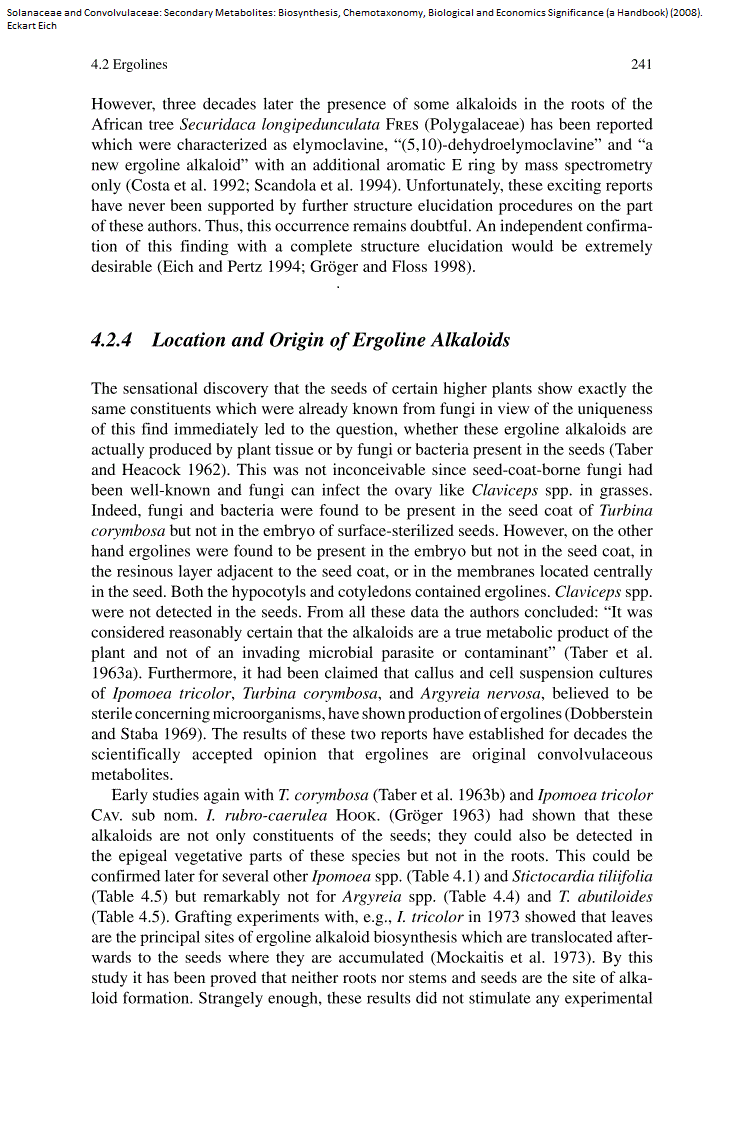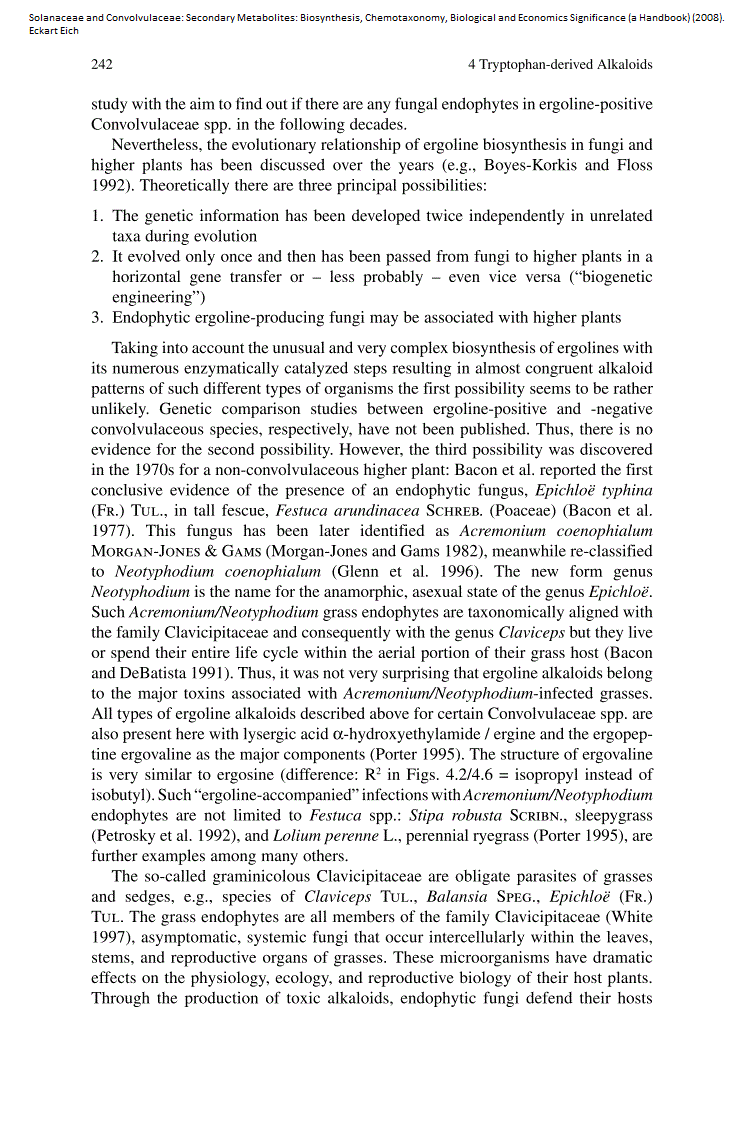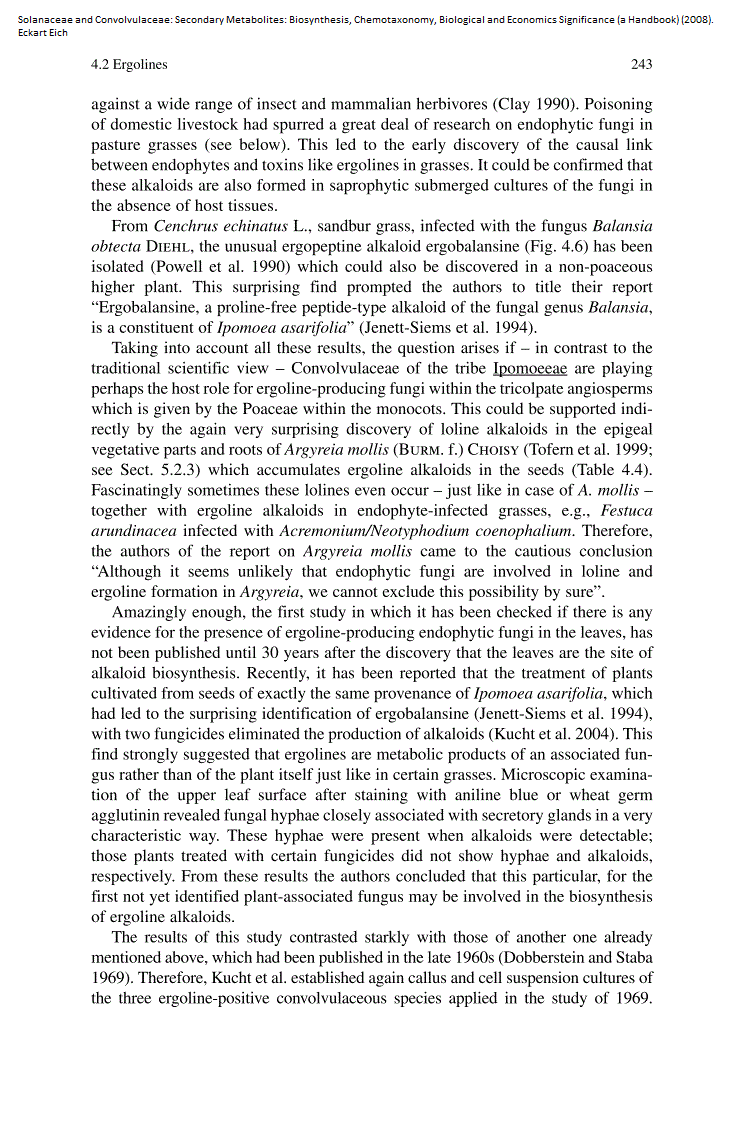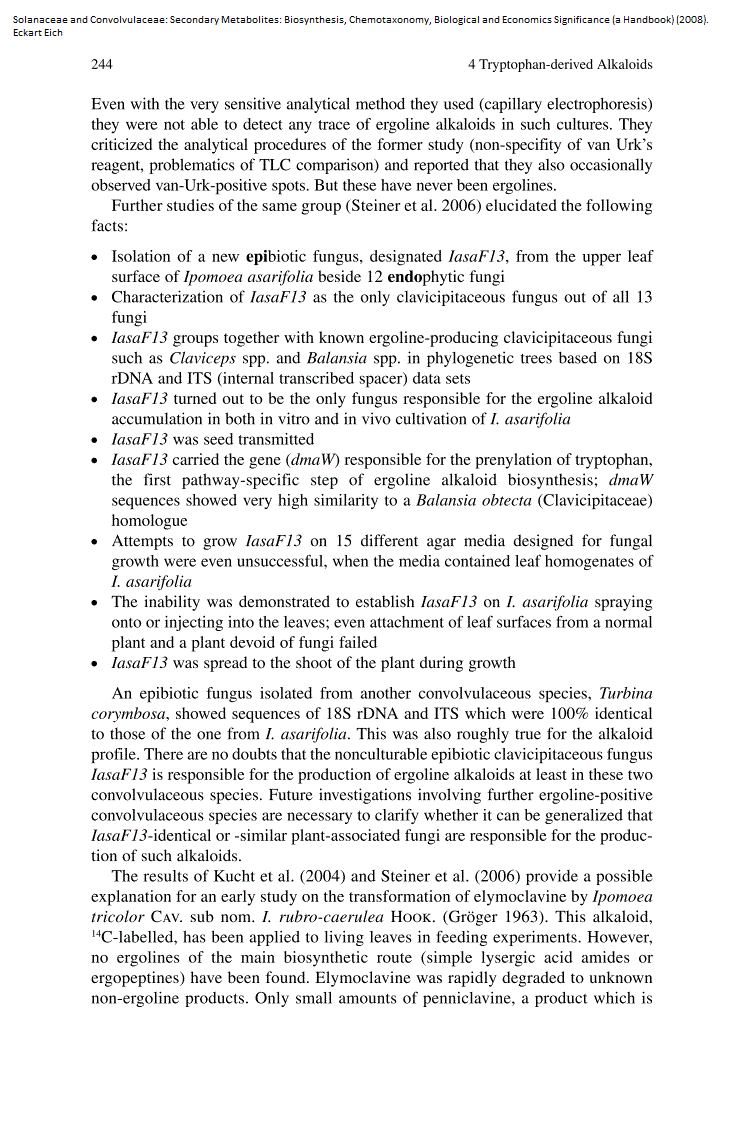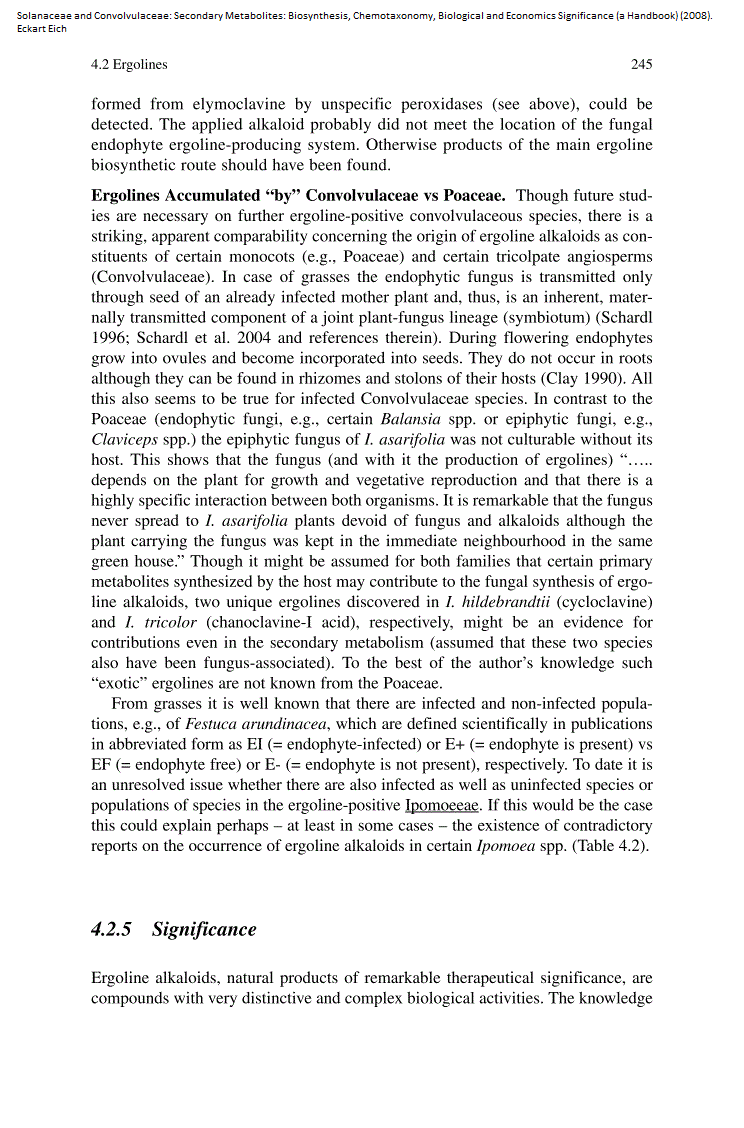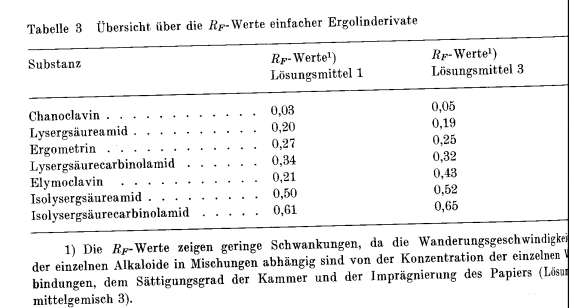It was my intention to post the below essay in my Journal, but it is too long for my Journal, so I'm posting it here. This essay is an attempt at tying together all the indications of the true psychoactive ergoline(s) in morning glory seeds.
Work-in-progress
-
Bruce Eisner: Well, people could say the same thing about LSD, they could say there’s sassafras and there’s nutmeg in nature, and there is morning glories and ergot in nature, but you have to do the chemistry in order to make something that’s effective.
Owsley: No, that’s not true. Ergot contains many natural, highly psychedelic alkaloids. Iso-ergine is one of them, hydroxyethyl-lysergamide* is another one, and in fact, is considered nearly identical to LSD in effect. Albert Hoffman told me so himself. They believe that it was this derivative contained in extracts of c.paspalum that was used in the Eleusian Mysteries.
Eisner, Bruce. "Interview with an Alchemist: Bear Owsley Interview."
Bruce Eisner's Writings DOWNLOAD
-
*Original article says hydroxy-methyl-lysergamide here: this is obviously a type-o. Hydroxyethyl-lysergamide is a synonym of lysergic acid hydroxyethylamide:
lysergic acid alpha-hydroxyethylamide
lysergic acid methyl carbinolamide
N-(alpha-Hydroxyethyl)lysergamide
(S)-9,10-Didehydro-N-(1-hydroxyethyl)-6-methylergoline-8beta-carboxamide
Ergoline-8-carboxamide, 9,10-didehydro-N-(1-hydroxyethyl)-6-methyl-, (8-beta)-
Lysergamide, N-(1-hydroxyethyl)- (7CI)
(8beta)-N-(1-hydroxyethyl)-6-methyl-9,10-didehydroergoline-8-carboxamide
Source: http://www.guidechem.com/reference/dic-628998.html
There are other minor issues with the above quote. Why did Owsley reference isoergine, but not ergine? Nichols says the iso epimers of lysergamides are generally inactive.[1] [But he goes on to say that isoergine might convert to ergine and that it might even result in more ergine at the receptor! How silly of me to have missed that. -08/31/22] And "
many natural, highly psychedelic alakloids?" More like one or two. Ergonovine has been found to be psychedelic,[2][3] but Bigwood et al (ref. # 3) found that unnaturally high doses were needed to achieve good effects. I think a typical ergot or morning glory seed preparation contains pretty low numbers of ergonovine; I still need to do calculations on the chemical analyses to see... Off the bat, I can say that Hofmann says this: "We were able to isolate the active principles responsible for the effect of these seeds and I was quite astonished to find out that these seeds contained as the active principles monoamide and hydroxyethylamide of lysergic acid and
a bit of ergonovine."[4]
Gröger 1963[5] found lysergic acid hydroxyethylamide ("LAH") to be in greater quantity than ergine in
Ipomoea tricolor seeds. Other analyses of morning glory seeds have found LAH to be in small amounts only. This disparity in analysis could indicate that LAH quickly decomposes when sitting in morning glory seeds;
fresh seeds may contain significant quantities of LAH. A web search will show that there is a rumor that only fresh morning glory seeds are truly psychedelic (i.e. see previous comment by user morninggloryseed in this thread:
#26).
By the way Shulgin believes the low LAH numbers could be due to harsh extraction procedures used during analysis (see references 9 and 10). A comparison between Gröger's procedure and the others' needs to be done to see if indeed the extraction procedures in those other analyses are eliciting the degradation of the compound. It may be that
both incorrect extraction and too much aging of seeds are responsible for low LAH numbers.
One issue with LAH is that it may simply convert to ergine in the body.[6][7][8][9][10] One Peter Webster pointed out at the 2006 LSD Symposium that ergine is unique in that it exists in three different forms ("...in many chemical and physical situations, the three forms are constantly converting themselves from one to the others, and achieving a typical equilibrium distribution.").[11] He feels that only an equilibrium of the three different forms of ergine produce maximal psychedelic effects. Webster doesn't acknowledge the presence of LAH in morning glory seeds, but I will add to his hypothesis that if LAH decomposes in the body,
the resulting ergine(s) may be different than the ergine(s) that arise via in vitro
decomposition (decomposition in the seeds during storage). Additionally, LAH may simply not decompose in the body.
This is a list of all the ergoline alkaloids that have been found in morning glory seeds. Note that many of these have only been found in small amounts.
chanoclavine-I
chanoclavine-II
rac. chanoclavine-II
agroclavine
festuclavine
dihydrolysergol-I (α-dihydrolysergol)
elymoclavine
lysergol
isolysergol
setoclavine
isosetoclavine
penniclavine
molliclavine
ergine
lysergic acid α-hydroxyethylamide
ergonovine
ergosine
Source: Solanaceae and Convolvulaceae: Secondary Metabolites: Biosynthesis, Chemotaxonomy, Biological and Economics Significance (a Handbook). Eckart Eich. 2008. pp. 241–245.[12]
These pages present tables showing all known ergoline-containing morning glory plants and all known ergolines contained in said plants. This selection can be downloaded here.
Chanoclavine is a prominent alkaloid found in these seeds, however Peter Webster has criticized its psychoactive potential:
Even the seldom faulted Merck Index lists chanoclavine as a possible active principle of ololiuhqui, a lysergic acid related alkaloid present in minor quantities in some samples of ololiuhqui and ergot as well, although no reports of its psychoactive nature have ever been reported. And indeed, if we believe the testimony of those who have told us how the Central American shamans prepare ololiuhqui, namely by cold water extraction of finely powdered seeds, then chanoclavine must be ruled out as it is almost totally insoluble in water. Chanoclavine is not even an amide. Nor has anyone shown any other chemical species in ololiuhqui to be suitably psychoactive.[11]
Shroomery member,
i_was_the_walrus commented on the above quote:
And I really doubt chanoclavine would be active. Of all the 4 isomers of LSD, only 1 is active. It seems to rely quite heavily on the optical specificity. With chanoclavine, the carbon (8 on LSD) is unsaturated and achiral. If it has any biological activity, I'm betting it would be well into the milligram range. (Mar. 22, 2015)[13]
As indicated at the beginning of this post, Owsley says Albert Hofmann told him that LAH is the true chemical essence of these seeds. However, as conveyed in this post, the validity of this statement is questionable.
Albert Hofmann
has spoken vaguely about the effects of
ergine:
-
Grof: Have you actually tried the ololiuhqui yourself? [uh-lowlee-uh-kee]
Hofmann: Yes, I did. But, of course, it is about ten times less active; to get a good effect, you need one to two milligrams.
Grof: And what was that experience like?
Hofmann: The experience had some strong narcotic effect, but at the same time there was a very strange sense of voidness. In this void, everything loses its meaning. It is a very mystical experience.
-
When I discovered lysergic acid amides in ololiuhqui, I realized that LSD is really just a small chemical modification of a very old sacred drug of Mexico.
-
Source: Reference #4.
Ololiuqui corrected as ololiuhqui
'NOTE: Although the spelling ololiuqui has gained wide acceptance and is now the commonest orthography, linguistic evidence indicates that this Nahuatl word is correctly written ololiuhqui.'
Note by R.E. Schultes included in the following essay: Notes on the Present Status of Ololiuhqui and the Other Hallucinogens of Mexico. R. Gordon Wasson. Botanical Museum Leaflets (Harvard University), vol. 20 (1963).
NOTE: Hofmann's "one to two milligrams" statement is an indication that he's speaking of ergine because in
The Road to Eleusis [1978] he uses the same phrase and he specifically mentions isolated ergine:
The effective dose of lysergic acid amide is 1 to 2 mg by oral application.[2]
As an addendum to this, in
LSD: My Problem Child (1979), Albert Hofmann states this: "the psychic effects of ololiuhqui, in fact, differ from those of LSD in that the euphoric and the hallucinogenic components are less pronounced."
The following article reports on the effects of isolated ergine in several human volunteers, however I can't read it as it's in German:
Heim E, Heimann H, Lukács G. 1968. Die psychische Wirkung der mexikanischen Droge „Ololiuqui“ am Menschen. Psychopharmacologia (Berl.) 13, 35–48.
DOWNLOAD
Reminder that in the first quote in this post, Owsley claims that Hofmann told him that LAH is nearly identical to LSD in effect and that LAH was the chemical essence of the Kykeon. This is the only commentary I'm aware of where Albert Hofmann said something important about LAH. LAH is only mentioned in passing
The Road to Eleusis[2] and in the interview with Stanislav Grof.[4] Furthermore Hofmann represents ergine as the only chemical of significance in both those publications. Perhaps Hofmann dismissed LAH because of the low numbers present in analyses of seeds but perhaps he eventually tried it in isolated form and achieved greater effects than those produced by ergine. As indicated earlier in this post, one analysis found LAH to be in greater quantity than ergine,[5] which contrasts with other seed analyses. Perhaps LAH is only found in large quantities in fresh seeds, thus there are two types of morning glory seed experiences: an LSD-like experience and an experience that can be described as a small fraction of LSD. It is rumored that in order to have a good experience on morning glory seeds, the seeds need to be fresh...
One cannot understand how Hofmann's experience with pure ergine matches up to morning glory seed preparations because his commentary is very brief. Assuming that the proposed fresh/LAH thing is true, presumably Hofmann's experiences with isolated ergine match seed batches that lack LAH and his experience(s) with LAH (as supposed by Owsley) match batches of seeds that are rich in LAH.
End for now.
1. Email that was probably sent to either
tregar or
Morninggloryseed, posted in tregar's 'Lucid and Visual Morning Glory LSA Extracts' thread on Mycotopia:
https://www.shroomery.org/forums/showflat.php/Number/27892316
2.
The Road to Eleusis: Unveiling the Secret of the Mysteries. R. G. Wasson, Albert Hofmann, and Carl A. P. Ruck, 1978.
See bottom of first column on page 10.
3. Entheogenic Effects of Ergonovine. Jeremy Bigwood, Jonathan Ott, Catherine Thompson, Patricia Neely. The Journal of Psychedelic Drugs, 11(1-2), Jan-Jun. 1979.
https://sci-hub.se/10.1080/02791072.1979.10472099
4. Stanislav Grof Interviews Dr. Albert Hofmann (1984). MAPS Bulletin 9.2 (Fall 2001): 22–35.
http://www.maps.org/news-letters/v11n2/11222gro.html
5. Gröger D. Über das Vorkommen von Ergolinderivaten in Ipomoea-Arten. Flora 153:373-382. 1963.
https://sci-hub.se/10.1016/S0367-1615(17)33310-4
NOTE: Lysergic acid carbinolamide is a synonym for lysergic acid hydroxyethylamide (see GuideChem reference at top of this post).
6.
easily decomposes in a weak acid solution to form ergine and acetaldehyde.
Stoll, A. and Hofmann, A. (1965) The ergot alkaloids. Located in R.H.F. Manske (ed.), The Alkaloids, Vol. VIII, Academic Press, New York, Chap. 21, p. 747
NOTE:
ergine is a synonym for
lysergic acid amide.
7.
ready cleavage under hot aqueous conditions, yielding D-lysergamide and acetaldehyde.
N. Castagnoli, jun., K. Corbett, E.B. Chain, and R. Thomas, (1970) Biosynthesis of N-(a-Hydroxyethyl)lysergamide, a Metabolite of Claviceps paspali,
Biochem. J., 117, 451
Note:
lysergamide is a synonym for
lysergic acid amide.
8.
The α-hydroxyethylamide spontaneously decomposes to lysergic acid amide, and the naturally-occurring amide may arise by this process.
Heinz G. Floss & John A. Anderson. 'Biosynthesis of Ergot Toxins' (1980) in
The Biosynthesis of Mycotoxins (Pieter S. Steyn, ed.), Elsevier, p. 21 (2012)
9.
this material is quite unstable and is easily converted in the process of isolation.
TiHKAL (part 1). Alexander Shulgin. 1997. P. 313
NOTE: Shulgin was obviously unaware of Gröger 1963 (ref. #5) where LAH was identified in a large quantity in
I. tricolor seeds.
10.
These compounds,* although well documented as components in the Convolvulaceae, are possibly lost in several of the analyses of alkaloid composition. They are extremely unstable, and are very readily degraded into acetaldehyde and the corresponding amide, ergine or isoergine. In these instances their presence will be measured only by the elevated levels of the derived amides.
Alexander Shulgin. Psychopharmacological Agents, Vol. 4 (ed. Maxwell Gordon), Elsevier, Dec 2, 2012
*lysergic acid hydroxyethylamide & isolysergic acid hydroxyethylamide
11.
Sacred Mushrooms of the Goddess and the Secrets of Eleusis. Carl A.P. Ruck (editor). Ronin Publishing. 2006. Chapter 15: Mixing the Kykeon Anew (171-189). Quote is from page 181.
Information about the chemical properties of ergine is on pages 179-181. The information in this chapter of the book was originally presented at the 2006 LSD Symposium. A video of this presentation is available here:
Code:
https://www.youtube.com/watch?v=uwfkJkvbR-I
Ergine information starts at 54:06 and ends at 1:08:47.
12. Solanaceae and Convolvulaceae: Secondary Metabolites: Biosynthesis, Chemotaxonomy, Biological and Economics Significance (a Handbook). Eckart Eich. 2008. pp. 241–245.
13. Shroomery member,
i_was_the_walrus. Personal correspondence. Mar. 22, 2015.

